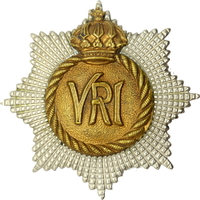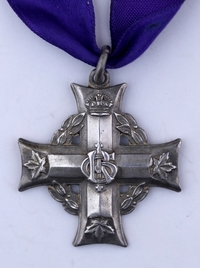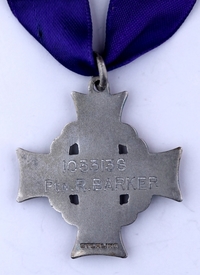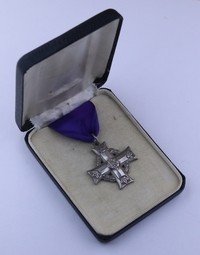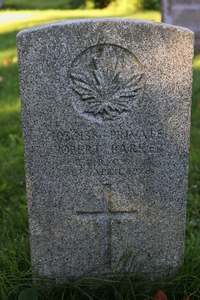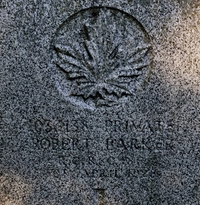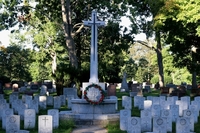
1033138 Private Robert John W. Barker
The Royal Canadian Regiment
By: Capt (ret'd) Michael M. O'Leary, CD, The RCR
Robert John W. Barker was born in York Township, Ontario, on 6 Dec 1878. His parents were Thomas, a paper maker, and Ellin (nee Pedlar) Barker. The family appears in the 1881 census for East York showing Thomas (27) and Ellen (27) with three children; John (6), William (4), and Robert (3). By the 1891 census, a fourth son, Thomas, was added to the family.
Barker married Alice Margaret Purvis on 20 Jun 1894. A page for Alice on Ancestry states she was 24 at the time of their marriage, and that barker was 20 (i.e., born in 1874). In 1892, two years before their marriage, the couple had a daughter, Merla.
Robert and Alice Barkers are shown in the 1901 census for West York. They are both recorded as 30 years of age with birthdates of 1 Jun 1870 and 24 May 1870, respectively. Sadly, Merla is not shown in the census record. Robert's employment is listed as Commercial Traveller earning $900 per year. The family next listed in the census are Albert V. (23), Harriet F. (22), and Gordon V. (1) Purvis. Albert Victor Purvis was one of Alice Barker's younger brothers. (The family name is spelled both "Purvis" and "Purves" in various records.)
In the 1911 census for Toronto East, the Barkers are living at 38 Balsam Street. Robert J.W. (40) and Alice M. (41) now have nephew Gordon V. Purvis (10) living with them. Robert Barker is recorded as working in the manufacturing of interior store fittings.
How Gordon Purvis came to be living with the Barkers is a mystery. His parents are absent from the 1911 census.
Brother-in-law Albert Purvis appears in the records of the Canadian Expeditionary Force (C.E.F.) as a soldier serving in the 7th Canadian Infantry Battalion (service number 16596). He claimed 18 months' prior service in the South African War with the S.A. Constabulary, his land grant shows "Kitchener's Horse," from April 1900 to February 1902. He also claimed seven years' Militia service with the Governor General's Body Guard (G.G.B.G.) when he enlisted for C.E.F. service in 1914. Purvis was gassed at Ypres, wounded at Festubert, and discharged medically unfit in September 1916. He died of diabetes mellitis in May 1919. In his C.E.F. service record, Purvis variously identified his wife ("Hattie F.") and his mother (Mrs. E.J. Purvis) as next of kin and his pay assignments for money sent home switched between the two women. On enlistment he stated his Mother was his next of kin and that he had one child, a son. On the medal card in his service record, Purvis' executor is listed as Mr. R.J.W. Barker of 437 Lansdowne Ave., Toronto. (The same address was one of those noted for Harriet in his records.)
Nephew Gordon Purvis ("Purves" on attestation) also served in the C.E.F. adding two years to his age to enlist with the Artillery in February 1916 (service numbers 315903 and 349092). He also claimed prior service, of four months with the G.G.B.G. Gordon listed his address at the time of enlistment as 38 Balsam St., and his father as next of kin at 437 Lansdowne Ave., Toronto. Struck off strength as a deserter in March 1916, Gordon apparently reconsidered and was back in the ranks from 2 May 1916, going on to serve in France and Belgium with the 5th Battalion, Canadian Railway Troops. He was discharged at Toronto on 15 Apr 1919. During his overseas service, Gordon made a monthly pay assignment of $20 to Mrs. R.J.W. Barker, 38 Balsam St., Toronto.
With his brother-in-law and nephew already in uniform, Robert Barker attested for service in the Canadian Expeditionary Force (C.E.F.) with the 237th Overseas Battalion at Halifax, N.S., on 17 Jul 1916. A 35-year-old labourer, Barker was described on his attestation paper as 5 feet 8 inches tall, weighing 135 pounds, with a 31-inch chest, a fair complexion, blue eyes, and brown hair. His religious denomination was Methodist. At the time of his attestation, Barker stated that he was not married and identified his mother, Ellen Barker, 204 1st Ave., Toronto, as his next of kin. On attesting with the 237th Battalion, Barker was given the regimental number 1033318.
On attesting with the C.E.F., Barker claimed prior service of "R.C.R., South African War." This is not corroborated by the records of the 2nd (Special Service) Battalion of the RCR which served in South Africa. There was, however, a Robert Barker that did service in South Africa with the RCR. Robert (Rybert) Kent Barker was an officer of the Queen's Own Rifles who served in "C" Company of The RCR in South Africa (1899-1900). He joined the Q.O.R. in 1888, after three years in the ranks was appointed to a commission in 1891, transferred to the Reserve of Officer in 1910, returned to active service in Canada and England from 1915 to 1920, and died in 1942.
It is possible that our Robert Barker had heard of the Q.O.R. officer of the same name (they do not appear to have been related)), and taking what he knew of his brother-in-law's South African service, decided to make a claim of similar service when enlisting in the C.E.F. Perhaps he expected that a cursory check would show his name on a South Africa roll, as long as the check did not turn up the disparity in rank and other military experience.
Barker's unit of enlistment, the 237th Battalion, C.E.F. was formed in mid-1916 at Sussex, New Brunswick. The unit recruited men in Military Districts 4, 5, 6, and 7. It was parenthetically titled "(American Legion)" and was one of a number of battalions in the C.E.F. that tried to recruit Americans. In September 1916, the unit's personnel were transferred to the 97th Battalion, C.E.F. This transfer occurred for Barker on 13 Sep 1916.
The 97th Battalion (American Legion), C.E.F., was authorized on 22 Dec 1915 and was recruited in and mobilized at Toronto, Ontario. The unit embarked for Britain, where its personnel were absorbed by the R.C.R. & P.P.C.L.I. Depot to provide reinforcements for the Canadian Corps in the field.
Soon after joining "D" Company of the 97th Battalion, Barker completed a form titled "Particulars of an Officer of man Enlisted in C.E.F." On this form he gave his home address as 132 First Ave., Toronto. He stated he was not married, was neither a widower, and had no children. Barker listed the same First Avenue address for both of his parents and identified his father as the person to be contacted with any formal communication.
On 14 Sep 1916, Barker also completed a military Form of Will. In this Will, Barker left all of his real and personal estate to his mother, Mrs. Ellen Barker. Barker's will was witnessed by "P. Beaumont," occupation "Professional Soldier." Percy Beaumont, an ex-officer of the British Army who had been dismissed from the Service, had re-enlisted as a soldier with the 237th Battalion, C.E.F., and also transferred to the 97th Battalion. Beaumont would reach The RCR in the field as a Private and regain a commission in the C.E.F. to serve as an officer of the Regiment by the end of the War.
With the 97th Battalion, Barker boarded the S.S. Olympic at Halifax, N.S., and sailed for England on 18 Sep 1916. The unit disembarked at Liverpool, Eng., on 25 Sep 1916. Five weeks later, on 31 Oct 1916, Barker was transferred to the R.C.R. & P.P.C.L.I. Depot.
The R.C.R. & P.P.C.L.I. Depot at East Sandling was a short-lived depot unit that supported those two named regiments with drafts of reinforcements. It was created on 13 Feb 1916 by separating it from the 11th Reserve Battalion, and it was disbanded on 20 Jan 1917 when it was absorbed into the 7th and 26th Reserve Battalions.
Barker would spent a month with the Depot before proceeding overseas on 30 Nov 1916 to The RCR. He landed in France on 1 Dec 1916 and was taken on the strength of The RCR as a reinforcement in a draft of 122 soldiers who were taken on the nominal roll of the Regiment that day. After less than two weeks at the Base Depot, Barker left to join the Regiment on 12 Dec 1916.
The RCR was relieved in forward trenches on the night of 13 Dec 1916 by the 49th Battalion and moved into Divisional Reserve. The next two days would see the men bathed and paid, and some attended a concert presented by the P.P.C.L.I. The War Diary of The RCR notes that on 16 Dec 1916, 111 other ranks were posted to the companies of the Regiment from the 7th Brigade Training Battalion, marking the final stage of barker's journey to the Regiment. The 7th C.I.B. Training Battalion was an element of the Canadian Corps Reinforcement Camp (C.C.R.C.) and would have been the holding unit that Barker and the other reinforcements would have remained with until sent forward to their units.
From falling into the ranks with his company on 16 Dec 1916, Barker's first period of service at the front with the Regiment would last six days.
The RCR remained in Divisional Reserve until the night of 19 Dec 1916. That afternoon the unit started its move forward and by 8.30 p.m. had relieved the 49th Battalion in the forward trenches. The Battalion remained in the lines until 24 Dec 1916, but Barker went out on 22 Dec 1916 when he was admitted to No. 9 and then subsequently No. 10 Canadian Field Ambulance with a diagnosis of bronchitis.
Barker was transferred to No. 42 Casualty Clearing Station (C.C.S.) on 26 Dec 1916, and his diagnosis changed to pleurisy (pains in the chest affecting the tissues around the lungs). Lower casualty rates in the winter compared to the heights of the summer campaign season meant that soldiers might remain in hospital longer in France. It was a month after Barker reported sick that he was transferred by No. 14 Ambulance Train on 22 Jan 1917 and admitted to No. 2 Canadian General Hospital, Le Treport, the next day. Two weeks later, on 6 Feb 1917, he moved again when he was admitted to No. 3 Convalescent Depot suffering from anaemia and debility.
After three weeks at the Convalescent Depot, Barker was ready to return to his unit. On 28 Feb 1917 he was posted to the Canadian Base Depot (C.B.D.) and on 3 Mar 1917 taken on the strength of "A" Wing, C.B.D. Six days later, on 9 Mar 1917, he left the Base Depot for the 3rd Entrenching Battalion.
The 3rd Entrenching Battalion was a Divisional Troops unit employed as a ready labour force and by design its troops were a forward reserve of reinforcements for the division's fighting battalions. They were also used as labour forces to maintain and build trenches or other work as needed.
Barker joined the 3rd Entr. Bn. and departed again on 25 Mar 1917. He arrived at the Regiment the same day as The RCR began its last rotation of front line duty before the upcoming assault on Vimy Ridge. By 1 Apr 1917, The RCR was out of the lines at Villers-au-Bois for a few days, and then they went into Grange Tunnel on 7 April to wait for the attack to begin.
While at Villers-au-Bois, the troops were busy with carrying parties as the final arrangements for Vimy Ridge were executed. Barker also had his first brush with the military justice system. On 4 Apr 1917 he was charged and tried by summary trial. Notes in his service record provide the context of the charge: "7 days C.B., placed under stoppages of pay to make good loss value £ 1 / 11 / 10. Lost by Neglect, 1 Bayonet and scabbard." The Regiment's Part II Orders add a bit more detail: "Losing by neglect 1 Bayonet and Scabbard Lee Enfield, 1 set Webb equipment Pattern 08."
Soon after the assault on Vimy Ridge, Barker was in trouble again. On 22 Apr 1917 he was placed under arrest and in confinement. He would be tried and convicted by a Field General Court Martial on 30 May 1917, charged with "When on Active Service absenting himself without leave." For his crime, Barker was sentenced to 30 days Field Punishment No. 1. This sentence was confirmed by Brig. Gen. A.C. Macdonnell, General Officer Commanding, 7th Cdn. Inf. Bde. on 6 Jun 1917. The Library and Archives Canada database for Courts Martials of the First World War includes the specific sections of the Army Act in its entry for Barker's court martial: "Court Martialed, 30-May-17 under AA Sections 15(1a), Absence without leave; and 4(7), Cowardice in the face of the enemy." For the latter charge, the specific wording in the Army Act is "Misbehaves or induces others to misbehave before the enemy in such a manner as to show cowardice."
While serving out his punishment on top of his daily duties, Barker remained with the Regiment, which in the months following Vimy started to return to the cycle of rotations in forward trenches, support trenches, and reserve positions that would characterize the infantry experience of the Great War. For the Regiment, it would also mean a period of rest and training from 14 Jun to 2 Jul 1917, returning to local support trenches from 3 to 9 July. This was followed by a day in Brigade Reserve and then into Divisional Reserve and another period of training from 11 to 19 Jul 1917.
Mid-way through the training period, on 14 Jul 1917, Barker went sick with trench fever. He was admitted to No. 9 Canadian Field Ambulance with a diagnosis of "P.U.O." (pyrexia, i.e., fever, of unknown origin). Ten days later, on 24 Jul 1917, he was transferred to No. 6 C.C.S. and soon after, on 28 Jul 1917, to No. 3 General Hospital, Rouen.
Barker's rearward movement in the medical system continued on 30 Jul 1917 when he was evacuated sick to England aboard the S.S. Essequibo. On leaving France, he was posted from the Regiment to the Nova Scotia Regimental Depot (N.S.R.D.) at Bramshott. The N.S.R.D. was part of the new regionally based reinforcement system, with named Depots taking in troops from battalions raised in those areas in Canada and providing reinforcement drafts to similarly designated fighting units. The RCR, having been headquartered in Halifax in the decade before the War, was associated with the N.S.R.D. These Depots also became the parent unit for any soldiers returned to England from their affiliated battalions in France and Flanders.
Barker was admitted to Bath War Hospital on 31 Jul 1917 with a diagnosis of trench fever. He spent a month at this hospital and was transferred on 27 Aug 1917 when he was admitted to the Canadian Convalescent Hospital at Bearwood Park, Wokingham, Berkshire. His case notes stated: "General Condition: Pains. Has continuous pains in shins and thighs during damp weather, occasional headaches, pale and anaemic, pulse good, easily fatigued and walks with a limp. Category Ciii permanent." Medical category "C" consisted of men who were considered fit for service in England only.
Barker appeared before a Medical Board conducted at Bearwood on 12 Sep 1917. His condition was described as: "General condition fair. Has constant pains in shins and thighs during damp weather. Occasional headaches. Pale and anaemic. Pulse good. Has had one year in France and is 49 years old. He is easily fatigued, and walks with a limp." The Board determined his medical category to be Ciii annotating it with "(is a teamster) (Permanent)." An age of 49 added ten years to Barker's actual age of 39, but it is possible that the effects of his condition were serious enough that that was the perceived age assessed by the doctors.
With little expectation that more time in hospital would improve his condition, Barker was discharged from hospital to N.S.R.D. Bramshott on 15 Sep 1917. Two days later he was posted to the N.S.R.D. Depot Company.
On 8 Oct 1917, Barker was in trouble again, being charged with "Unshaven on 8.15 a.m. parade." The summary trial was conducted the same day by Capt. Hugh P. Bell, the witness was Sgt. Douglas, and Barker was found guilty. He received a punishment of four days' Confinement to Barracks (C.B.).
Less than a week later, on 13 Oct 1917, Barker was sent On Command (i.e., a temporary assignment without change of parent unit), to the Canadian Discharge Depot (C.D.D.) at Buxton. Here he was to await embarkation for Canada where his further service, if any would be determined by the offices of the Adjutant General (A.G.) Ottawa.
It appears from his file that Barker missed his first opportunity to sail for Canada. On 19 Oct 1917 he was charged again. This time the summary trial was conducted by Lt.-Col. P.R. Hanson and the charge read: "Absent from sailing parade." Witnesses called were Cpl. Murray and C.S.M. Reynolds. Barker was again found guilty and awarded punishment of seven days' loss of pay under the Army Act, Section 46.2.d.
Barker's behaviour didn't necessarily improve though he seems to have avoided any more charges. On 1 Nov 1917, he was pronounced dentally fit. This assessment was largely speculative, as his form was also annotated with "Failed to attend Dental Parade."
Finally, on 6 Nov 1917, Barker's service overseas came to a close when he embarked for Canada at Liverpool. On embarkation, he ceased to be On Command C.D.D. Buxton and was struck off strength to the C.E.F. in Canada. Although it is unlikely to have been his actual arrival date, responsibility for Barker preceded him and on 11 Nov 1917 he was posted to a Convalescent Home, "D" Unit, Military District No. 2, Toronto.
On 27 Nov 1917, Barker's medical condition and its effects were considered by a Medical Board at the Discharge Depot, Quebec, Que. The three listed causes of his disability were:
"(1) Chronic Bronchitis.
(2) Debility (convalescent from Trench Fever).
(3) Overage, 49 years."
The conditions that prevented Barker from returning to his livelihood as a teamster were detailed as follows:
"France, 8 months. Returned July 1917 with trench fever. Since then feet and legs have been painful, more especially along shins in damp weather.
"Present Condition. Poorly nourished, weakened. Has lost 15 lbs weight and is anaemic. States he has had cough since arrival in France.
"Respiration. Harsh breathing both mungs. Prolonged exp. Both apices, moist scales right apex and both bases. (Shins painful only in wet weather.)
"Requires rest and further treatment."
The Board determined that Barker suffered from a 25% disability although it was decreasing. His disability was expected to last three months and in response to the question "Does it render him permanently unfit for Military Service?" The board's written reply was the inexplicable "Average."
On 1 Dec 1917, Barker was taken on the strength of "D" Unit, Military Hospitals Commission of Canada (M.H.C.C.) Toronto. On 10 Dec 1917, he was admitted to Whitby Military Hospital. Barker's medical case file was noted with: "Chronic bronchitis, Debility, Overage." From 1 Dec 1917, Barker was an outpatient at the Whitby Hospital.
A Medical History of an Invalid form was completed on Barker at Whitby on 14 Jan 1918. Noting his home address as 132 First Ave., Toronto, the personal information on the form included an age of 49 and a date of birth of 6 Dec 1868, adding a full decade to his age. Barker's disability was identified as overage and debility caused by bronchitis and trench fever, having begun in France in June 1917.
Barker's present condition at the time was: "Patient has no complaints. Pains in legs have cleared up. He has no cough or sputum. He can walk easily a couple of miles and double a couple hundred yards with only very slight dysponoea. Chest is emphysematous, slight, with fair expansion. There is an occasional squeaking and musical rale. Pulse is 90 standing. Heart sounds are fair. First inclined to be a little soft. Incapacity is due to general weakness. There is a slight amount of anemia."
A note of Barker's medical history noted: "Distal phalanx of right index finger was taken off previous to enlistment." Curiously, this was not recorded on his enlistment medical form.
Barker was assigned a 10% disability expected to last a further six months. The prescribed treatment was rest. The Board accepted that Barker claimed to feel as well as he did on enlistment and recommended discharge on grounds of his being overage.
After signing the Medical History form, Barker decided to take two weeks unapproved leave. A cryptic notation in his records indicates that he was charged on 30 Jan 1918 for being absent without leave from 14 to 30 Jan 1918. For his crime, he forfeited 14 day's pay.
After 1 year and 197 days of service, Barker was discharged from the C.E.F. at "D" Unit, M.H.C.C., on 30 Jan 1918. The terms of his discharge specified "Being no longer fit for war service" (Para. 392, Sec. 16, K.R.&O. 1912). Barker's military character on discharge was recorded as "Good."
Barker received Post Discharge Pay of $100.10. This was paid in three installments from February to April, 1918. On discharge, Barker was eligible to receive a War Service Gratuity of $280. Previously paid Post Discharge Pay was part of this Gratuity, Barker received a cheque for a further $179.90.
The Barkers were still living at 38 Balsam St. in Toronto at the time of the 1921 census. R.J.W. (48) and Alice M. (46) are sharing their home with nephew Walter Butters (28), niece Edna M. Butters (28), and sister Annie V. Purvis (51). Robert Barker's employment is recorded as manager.
For his service in the C.E.F., Barker was entitled to receive the British War Medal and the Victory Medal. These were despatched to him at Westminster Hospital, London, Ont., on 14 Mar 1923.
Robert Barker died on 30 Apr 1928 at London, Ontario. His cause of death was recorded on his C.E.F. Circumstances of Death form as "pulmonary tuberculosis and dementia praecox." Barker's Veteran's Death Card confirms that the cause of death was considered related to his war service which established the eligibility to issue the Memorial Cross in his name. His next of kin on the form was his mother, Mrs. Ellen Barker, 352 Riverdale Ave., Toronto, Ont. The registration of Barker's death noted that he had been living in London for the previous eight years, had died at the age of 54 years 4 months, his trade was Teamster, and that he had died at Westminster Hospital. Barker was buried in the Soldiers' Plot at Mount Pleasant Cemetery in London, Ont.
Following Barker's death his mother received a Memorial Cross, while a Memorial Plaque and Scroll were sent to his father. The Cross, Scroll, and Plaque were despatched in 1928 and 1929. At the time, Barker's parents were living at 352 Riverdale Ave., Toronto. It does not appear that any Cross was issued to Alice Barker.
Providing one more small mystery around Barker's military service, there are two service numbers recorded on his Veteran's Death Card and on the Medal Card (for Memorial Cross and Plaque) in his service record. These numbers are his C.E.F. service number, 1000318, and another annotated with "P.F." (Permanent Force), 2264.
The number series "2001-3000" was used by the Infantry School Corps for enlistments at Fredericton from 1884 to 1894. The company changed to the "6xxx" series of numbers in April, 1894. In the collection of The RCR Museum is an original Service Roll book from "A" Company of the Infantry School Corps (Fredericton) which records enlistments from January 1884 to July 1905. It is not until May 1892 that a column on each page is dedicated to regimental numbers. Numbers assigned to soldiers listed on all previous pages are inserted over their names but there is a randomness to the order of the numbers that suggests another source document was used to pair numbers with names.
There are five "226x" regimental numbers in the Service Roll book, assigned to men enlisted between March 1886 and January 1887. Numbers 2261, 2262, 2263, 2265, and 2266 are listed. But the regimental number 2264, which Barker claimed, is curiously absent. The missing numbers in the series may have been assigned to men whose enlistments did not last long enough to be recorded in the Service Roll book, either through being identified as unfit by the Commanding Officer or Medical Officer, or who deserted very soon after their enlistment and their names did not make it to the Service Roll.
It is unlikely that Barker enlisted in the Infantry School Corps in Fredericton in 1886, when according to the family's appearance in census records he would have been an eight year old boy in Toronto.
In the Fredericton Service Roll, regimental number 2263 belongs to Private Charles W. Belyea, enlisted on 27 Mar 1886. Regimental number 2265 belongs to Private John T. Kay, enlisted 1 Jan 1887. The randomness of assigned numbers in the volumes is evident when the data is resorted by attestation dates, 26 other other soldiers in the roll were enlisted between Belyea's and Kay's joining dates.
The mysteries around Barker's variable age records, his marriage, and his association with a Permanent Force service number will have to remain unanswered for now. For now, he rests in the Soldiers' Plot at the Mount Pleasant Cemetery in London, Ontario, with others who have served.
Pro Patria
Visit a randomly selected page in The O'Leary Collection (or reload for another choice):
- The O'Leary Collection; Medals of The Royal Canadian Regiment.
- Researching Canadian Soldiers of the First World War
- Researching The Royal Canadian Regiment
- The RCR in the First World War
- Badges of The RCR
- The Senior Subaltern
- The Minute Book (blog)
- Rogue Papers
- Tactical Primers
- The Regimental Library
- Battle Honours
- Perpetuation of the CEF
- A Miscellany
- Quotes
- The Frontenac Times
- Site Map
QUICK LINKS
The O'Leary Collection—Medals of The Royal Canadian Regiment
Newest additions:
![]()
![]() SB-12725 Private Henry "Hank" Ard
SB-12725 Private Henry "Hank" Ard ![]()
WIA at Hill 187, Died of Wounds in Japan
![]()
![]() 2355331 Lance Corporal Albert Lorking
2355331 Lance Corporal Albert Lorking
Wounded in action, later a War Amps representative.
![]()
![]() 4334 / 477996 Pte Isaac Hamilton Wilcox
4334 / 477996 Pte Isaac Hamilton Wilcox
Permanent Force, South Africa, and C.E.F.
![]()
![]() 477019 Private Harold Ashcroft
477019 Private Harold Ashcroft
Transferred to the Tunnelers.
![]()
![]() 734231 Private Clark D. Thompson
734231 Private Clark D. Thompson ![]()
The older Thompson brother, killed in action.
![]()
![]() 733849 Private Norman Parker Thompson
733849 Private Norman Parker Thompson
The younger Thompson brother; post-war service in the Special Guard.
![]()
![]()
![]() A305 / 400305 Private Andrew Walker
A305 / 400305 Private Andrew Walker ![]()
"Previously reported Wounded, now Killed in Action."
![]()
![]() 823298 Pte Thomas Patrick Steele, M.M.
823298 Pte Thomas Patrick Steele, M.M. ![]()
… for gallant conduct in the field …
![]()
![]() P13066 Sergeant Harold Thompson
P13066 Sergeant Harold Thompson
Instrumental Soloist for over 20 years of Canadian Army service.
![]()
![]() 9609 / 477728 Private Albert Edward Piper
9609 / 477728 Private Albert Edward Piper
"Arrived from England as a STOWAWAY …"
